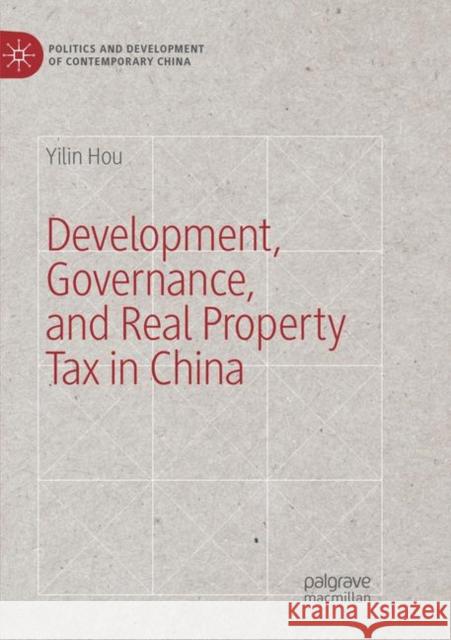Development, Governance, and Real Property Tax in China » książka



Development, Governance, and Real Property Tax in China
ISBN-13: 9783030070519 / Angielski / Miękka / 2018 / 198 str.
Development, Governance, and Real Property Tax in China
ISBN-13: 9783030070519 / Angielski / Miękka / 2018 / 198 str.
(netto: 268,97 VAT: 5%)
Najniższa cena z 30 dni: 269,85
ok. 22 dni roboczych
Dostawa w 2026 r.
Darmowa dostawa!
1. Introduction
2. Why the Real Property Tax? A Fiscal System’s Approach
2.1. A Fiscal System’s Approach2.1.1. Tripod structure of modern tax systems
2.1.2. Direct vs. indirect taxes
2.1.3. Regressive vs. progressive taxes
2.1.4. Tax allocation among government levels2.2 Evolution of Taxation in New China
2.2.1 The pre-1949 tax state2.2.2 The no-tax state from the mid-1950s to the late 1970s
2.2.3 Public provision mentality
2.3 Fiscal System Reforms 1978-2015: Reestablishing the Taxation System
2.3.1 Corporate and personal income taxes
2.3.2 Value added tax2.3.3 The missing foot of the tripod
2.4 Intergovernmental Fiscal Relations
2.5 Towards a Local Property Tax – the Window Paper Effect
3. Housing Provision Reform and the Real Estate Sector 3.1. Housing Provision Reform: from Free Provision to Market to Mixture3.1.1. Genesis of the reform
3.1.2. Shift from free provision to market mechanism
3.1.3. Central blueprint vs. local implementation
3.1.4. The comfortable housing project 1995-97
3.2. Real Estate Sector as the Pillar of Economic Growth3.2.1. Housing construction and economic growth
3.2.2. Muddling through of housing market intervention
3.3. Ad Hoc Preparations for the Real Property Tax
4. Why China Needs a Real Property Tax – Empirical Evidence
4.1 Value Capture and Basic Education in China
4.1.1 School system setup and finance
4.1.2 Imposed school tiers and inequity4.1.3 Market housing price: capitalization and sorting
4.2 Related Literature
4.2.1 Static (cross-sectional) studies
4.2.2 Dynamic studies
4.3 Data and Methodology4.3.1 Hypotheses
4.3.2 Sample area and data collection
4.3.3 Estimation methods
4.3.4 Hedonic features and neighborhood amenities4.4 School Reputation, Policy Shock, and Capitalization
4.4.1 Effects of school tiers on housing price
4.4.2 Effects from strict enforcement of the proximity rule
4.4.3 Parallel trend test of the DID model4.5 Summary and Conclusion
5. Institutional Obstacles to China in Adopting the Real Property Tax
5.1. Private Property Right – Land Rights5.1.1. Land rights in rural areas
5.1.2. Land and real property rights in urban areas
5.2. Land Use Rights – Leasing by Local Governments
5.3. Dilemma of Direct Taxation5.4. Debates around Adopting the Real Property Tax
5.4.1. Over-concern for protecting the have’s
5.4.2. Under the excuse of protecting the have not’s
5.5. Seeking the Window Paper Breaker(s)5.5.1 Typology of the window paper breakers
5.5.2 Window paper breakers in China’s reforms since 1978
5.5.3 Window paper breakers in adopting the real property tax
6. Principles for the Design of the Real Property Tax
6.1. Equity
6.1.1. Equity as the foundation block of real property taxation
6.1.2. Definition, perception, and actuality of equity 6.1.3. Equity in tax burden distribution6.1.4. Tax base and exemptions
6.1.5. Tax rate: progressive or not
6.2. Efficiency
6.2.1. Defining efficiency in taxation
6.2.2. Equity vs. efficiency: a trade-off6.2.3. Efficiency and feasibility
6.2.4. Allocative efficiency
6.2.5. Rental properties market
6.2.6. Examples of exemption proposals that go against efficiency6.3. Feasibility
6.3.1. Political acceptability: fairness in tax administration
6.3.2. Administrative feasibility: convenience for taxpayers
Appendix 6.3: Aspects of Real Property Tax Administration
6.3.3. Tax assessment office
6.3.4. Assessment frequency6.3.5. Approaches of property assessment
6.3.6. Administrative cost
6.3.7. Resolution of appeals
6.4. Transparency6.4.1. Essential features of tax transparency
6.4.2. Local registration of properties
6.4.3. Unified national network of real property registration
6.4.4. Public budgeting system6.5. Adequacy
6.5.1. Real property tax as a local tax
6.5.2. Major revenue source
6.5.3. Recurring revenue source
6.5.4. Intergovernmental transfers and moral hazard6.5.5. Local real property tax and inter-jurisdictional fiscal disparity
6.6. Stability
6.6.1. Inelastic demand for housing
6.6.2. Stable revenue source
6.6.3. Use of property tax revenue: two opposite examples
6.6.4. Mechanism for cyclical stability of revenue
6.7. Six Principles as a Framework for New Tax Design 7. Strategies for Implementing the Local Real Property Tax7.1. Dilemma: Deep-Rooted Centralization Tradition
7.2. Key Elements of the Implementation Plan 7.2.1. Open and participatory law making 7.2.2. Central authorization for local implementation 7.2.3. Local discretion with no uniform scheme 7.2.4. Window for adjustments and preparations 7.3. Other Related Matters7.3.1 Incentive for and accountability by local governments
7.3.2 Self-reinforcing compliance
7.4. Proposed Design: A Local Real Property Tax for China
7.4.1. Four tax elements
7.4.2. Four implementation measures
7.4.3. Three related institutions8. Simulation of Tax Incidence and Redistribution Effects of the Tax Proposal
8.1 Introduction
8.2 Related Literature
8.2.1 Three waves of ability-to-pay research8.2.3 Studies of willingness-to-pay
8.2.4 Tax incidence and equity
8.3 A Theoretical Framework of Ability-to-pay and Willingness-to-pay
8.3.1 Ability-to-pay based on the bidding and sorting model8.3.2 Measuring ability-to-pay
8.3.3 A theoretical model of willingness-to-pay8.3.4 Measures of willingness-to-pay
8.4 Data, Methods and Results
8.4.1 An analysis of ATP indexes
8.4.2 WTP: inter-household/region differences and their determinants
8.4.3 Consistency between ability-to-pay and willingness-to-pay
8.4.4 Tax burden distribution and redistribution effects
8.4.5 Determinants of net benefits
8.5 Comparative Analysis of Alternative Exemption Thresholds
8.5.1 Impact of local property tax on government finance
8.5.2 Linking ability-to-pay with willingness-to-pay
8.6 Discussion and Conclusion
9. Conclusion: Towards Balanced Development and Harmonious Governance
9.1 Lessons learned
9.2 Challenges ahead1997-2025 DolnySlask.com Agencja Internetowa
KrainaKsiazek.PL - Księgarnia Internetowa









